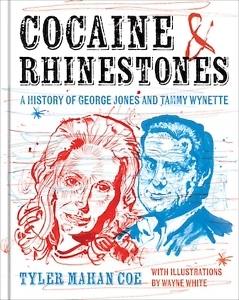Tragicomic Collaboration
Tyler Mahan Coe limns a legendary country music marriage in Cocaine and Rhinestones
The story Tyler Mahan Coe tells in Cocaine and Rhinestones: A History of George Jones and Tammy Wynette is about how the two greatest singers in country music history balanced conservatism and innovation in a blatantly commercial genre.

George Jones made some of his best music with the record producer Billy Sherrill, an intellectual working in a form that prizes the authentic moment. Tammy Wynette achieved fame by singing an anti-feminist song, “Stand by Your Man,” that Sherrill had been working on for years and which came to life when Wynette helped him finish writing it in August 1968. She delivered it in a voice that was tinged with the bravura of the eternal victim. Like Jones, she was a vocalist whose interpretations verged on the uncanny. They were almost as famous for their vocal duets as they were for their tumultuous marriage and subsequent divorce, and their intertwined stories encapsulate a highly charged moment — the late 1960s and early 1970s — in country history.
Tyler Mahan Coe, who is the son of country singer and songwriter David Allan Coe, came to fame in 2017 when he began releasing episodes of his podcast Cocaine & Rhinestones. A researcher of genius, Coe is also a myth-buster in a field that seems to encourage writers to believe what Coe deems misconceptions. Coe went deeply into the lives and careers of figures like Spade Cooley and Jeannie C. Riley during the first season of Cocaine & Rhinestones. He devoted most of season two to telling the story of Jones and Wynette, and his book is based on those podcasts.
Because Coe understands the dynamics that propelled Alabama-born Billy Sherrill to create pop music in a country style, the book comes with a built-in intellectual framework. Coe sees the work of Jones and Wynette with Sherrill in the 1970s as crossover music that tends to confound rock and pop critics who look at country from the outside:
Therefore, it is often fans, journalists and even artists approaching country from backgrounds in pop (or rock) music who themselves have this authenticity fetish, which they project onto fans of whatever subculture they’ve just discovered and hope to join. That is how and why producers like Chet Atkins and Billy Sherrill were able to consciously and deliberately sell the country genre to such fans in a pop crossover package, by taking country singers, giving them compelling personas and placing them within a sonic context that metropolitan listeners found compelling.
What this process means is that Sherrill — drawing from the work of pioneering Nashville producer Owen Bradley, who worked with Patsy Cline and many others — created a series of brilliant records for Jones and Wynette (and to a lesser degree, Tanya Tucker) — that capitalized on the vivid personalities of the singers themselves. Music journalist Robert Christgau succinctly describes this strategy in his review of Jones’ 1982 Anniversary: Ten Years of Hits: “…Sherrill gives up on forcing Jones into the mold, instead encouraging his prize to be what he is, the greatest country singer in history — not so much with arrangements, though they do get sparer, as with increasingly hyperbolic and goofy material.”
 Sherrill, Jones, and Wynette produced art that was tragicomic, as in Jones’ 1974 sublime “The Grand Tour,” or postmodernist, as in 1976’s “Billy Ray Wrote a Song,” where a Jones-like character’s antics on the road inspire a fictional professional songwriter named Billy Ray to create the stories the real George Jones sings. Wynette’s 1970 hit “He Loves Me All the Way” is, like “Stand by Your Man,” a musically brilliant and lyrically conservative masterpiece. Still, both Jones and Wynette were inconsistent artists who produced forgettable music — the inevitable result of the commercial pressures they felt.
Sherrill, Jones, and Wynette produced art that was tragicomic, as in Jones’ 1974 sublime “The Grand Tour,” or postmodernist, as in 1976’s “Billy Ray Wrote a Song,” where a Jones-like character’s antics on the road inspire a fictional professional songwriter named Billy Ray to create the stories the real George Jones sings. Wynette’s 1970 hit “He Loves Me All the Way” is, like “Stand by Your Man,” a musically brilliant and lyrically conservative masterpiece. Still, both Jones and Wynette were inconsistent artists who produced forgettable music — the inevitable result of the commercial pressures they felt.
Coe is a discursive writer who lines out the parallel lives of Jones and Wynette by examining the fabulist tendencies of the most famous married couple in country history. For every tall tale of marital strife Wynette spins, Coe finds a conflicting narrative, and thus is truth served. (Coe regularly cites Jimmy McDonough’s indispensable 2010 Tammy Wynette: Tragic Country Queen, a thoroughly researched biography.)
Some of Coe’s discursions seem peripheral to the story, and why he chooses to write about Catherine de’ Medici and medieval jousting remains opaque to me. On the other hand, his concise chapter on the history of moonshine whiskey makes sense in a book about a singer who sang a tune called “White Lightning.” Tennessee-born artist Wayne White’s accompanying drawings for Cocaine and Rhinestones are appropriately droll and dark — pop culture gone gently askew. For anyone who wants to know how and why country music gets made, Coe’s deep dive leads you to a huge number of recordings created by quintessential American artists who stayed country by going pop all the way.

Edd Hurt is a writer and musician in Nashville. He’s written about music for Nashville Scene, American Songwriter, No Depression, The Village Voice, and other publications. He produced and played keyboards on The Contact Group’s 2021 album of 1970s covers, Varnished Suffrages.


